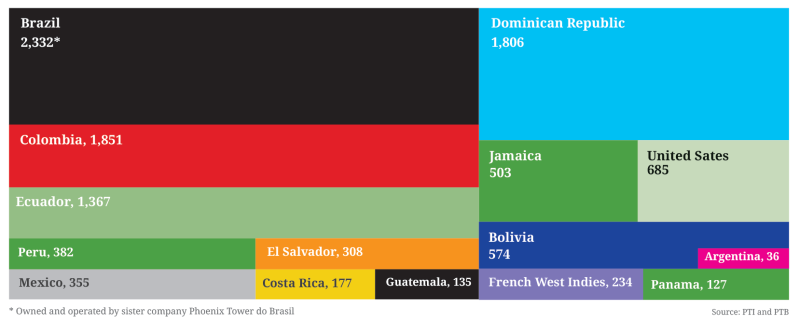In October 2013, Dagan Kasavana launched Phoenix Tower International (PTI), a start-up towerco that quickly expanded from its Boca Raton headquarters through the United States, Latin America and the Caribbean to become one of the fastest growing telecom infrastructure players in the region. PTI’s CEO Dagan Kasavana recruited an experienced team of towers’ masterminds that had previously worked together at Global Tower Partners (GTP)—including current Executive Chairman Tim Culver and Natalya Kashirina—prior to a US$4.8bn sale to American Tower. From the very beginning, Kasavana and his team bet on a creative growth strategy that combined strategic acquisitions with partnerships with local developers and successful build-to-suit initiatives. Six years later, the company owns a portfolio of more than 8,500 site across 14 countries. Here is a narrative of PTI’s success story.
Started from the bottom
2014 – After launching in 2013, PTI’s first year was all about building a solid foundation, where every little step counted. In 2014 the towerco acquired around 20 sites in Costa Rica and later on, it purchased 100 newly constructed towers from a developer in the country. The company also entered Panama by acquiring 60 sites from American Tower and closed other small tower transactions in Colombia and the United States as well as investing in systems to scale the business, still in use today. PTI also hired Shylesh Moras, the company’s current SVP of Operations. Securing Blackstone’s support and trust was critical from the beginning and in less than a year, PTI was operating 1,608 towers across six countries.
2015 – This year marked the beginning of the Caribbean adventure for PTI. Dagan and his team secured the required debt financing with Scotiabank to acquire 189 sites in the Dominican Republic, where the company has now established one of its most strategic hubs. While many towercos thought that achieving scale in the Caribbean was an impossible mission, PTI decided to bet on it and became the first independent towerco in this fragmented region with an actual portfolio of over 2,800 sites across the Dominican Republic, Jamaica and the French West Indies, mainly developed through acquisitions from MNOs such as Altice and Digicel.
Since its entrance, PTI has achieved tremendous success in the region, scaling its operations and securing excellent lease-ups. Given it was the only independent tower company in the Caribbean, PTI had also established direct C-level relationship with their MNO customers across the region, which is usually more difficult in bigger markets, and which helps PTI in getting a better understanding of their needs and required solutions. The dynamism of those markets and the increasing data demand will keep driving organic growth. Additionally, the Caribbean still presents some interesting M&A opportunities.
In the same year, the company solidified its presence in the United States. PTI secured debt financing for its domestic assets from TD Bank and closed the acquisition of 612 towers from operator T-Mobile.
To complete a successful and busy 2015, PTI also acquired Brazilian towerco T4U and penetrated one of the most dynamic and largest tower markets in Latin America. The company also obtained 180 BTS orders in the country and decided to spin off the investment and its other Brazilian assets under Phoenix Tower do Brasil (PTB), which now operates a portfolio of 2,332 towers as a separate Blackstone entity.
Phoenix Tower International portfolio

A regional footprint
When Dagan conceived PTI, he always envisioned creating a multi-country towerco, with aggressive growth targets achievable only by successfully operating across various markets. His mission has proven right and PTI, with its footprint and presence across 14 different countries, is a fast-growing towerco which retains its entrepreneurial spirit. “Our business plan was to create a multinational towerco from day one. The challenge is to grow, scale and operate as a best-in-class tower company while retaining the energy of an entrepreneurial start-up – that energy that carriers, developers and landlords love.” Dagan told us.
Back in 2015, the Central and Latin American tower markets were very competitive but not many companies were willing to take orders of ten or 20 sites. PTI not only did that but also started buying relatively small portfolios of around 100 sites, which was quite a unique approach. While other investors and towercos were reluctant to enter some markets through small acquisitions, this strategy granted PTI a competitive edge in several countries.
Geographical diversification allows Phoenix Tower to continue scaling its business and achieving growth while diluting the political and economic risks inherent to some CALA markets. Further, this approach allows PTI to have multi-faceted regional vision and expertise – a definitive plus when engaging with regional operators such as América Móvil, Millicom and Telefónica.
Ecuador is a great example of PTI’s successful strategy. For a while, the company had a very small presence and until two months ago, it only owned 48 sites in the country. However, its small footprint still granted PTI that local knowledge and expertise that proved instrumental to acquire over 2,400 towers from Telefónica in both Ecuador and Colombia last December.
In Ecuador, Phoenix now owns 1,367 sites, becoming one of the biggest independent players there. The towerco also remains optimistic about Colombia, where PTI owns 1,851 sites. Patience and resilience are critical when operating in Colombia, where the spectrum auction kept getting postponed for the past three years and just took place. Many smaller players exited the market due to the lack of deployment activities, allowing PTI to absorb some assets.
The spectrum auction finally took place at the end of last year and towercos foresee good volumes of BTS and lease-up over the next few months in the country. On top of their own portfolio, PTI enjoys the marketing rights to ~1,900 sites in Bogotá and Medellin, obtained through Syscom’s acquisition back in 2017.
2016-2017 – PTI commenced operations in Peru in 2016 by engaging in BTS with various operators and signing development partnerships. A year later, the company also acquired 200 towers from Digicel in El Salvador, where it now owns a portfolio of 308 sites. PTI also owns small portfolios of 135 and 26 sites respectively in Guatemala and Argentina. An initial footprint that could give PTI an edge when and if these markets present further growth opportunities.
2018 – This was a critical year for PTI from a financing point of view. After refinancing its Scotiabank and Banco General loan facilities a year before, the company recapitalized the business when Blackstone sold a minority stake of the company to John Hancock. PTI also secured US$200mn from Goldman Sachs to finance further domestic expansion in the United States and obtained more capital from Scotiabank and other lenders to continue its international growth and allowing it to close transactions with Altice in the Dominican Republic and Digicel in Jamaica, furthering its Caribbean presence.
PTI’s main acquisitions (2014-2019)

What does the future hold?
Whereas Latin American MNOs are still rolling out and upgrading 3G and 4G networks, the United States are all about 5G. Around a year ago, PTI acquired Syscom Telecom, adding over 80,000 marketable small cell wireless communication sites in the U.S. to complement its 685 macro-towers.
PTI is now expanding that business stream while also working directly with its clients on DAS initiatives and exploring innovative site typologies such as billboards and urban furniture. Meanwhile, Phoenix will continue to scout new opportunities and revenue streams that make sense for their business objectives. “We want to make investment that are complementary to our towers, which still provide 90% of our profit. We want to continue building and acquiring fibre, DAS and small cells but we won’t be entering new lateral businesses that don’t serve our customers’ needs directly,” Dagan stated.
Although CALA is behind in terms of network innovation, 5G is already on the table and some countries such as Brazil, Chile and Peru are expecting spectrum auctions to take place over the next 12 months. Gearing up for the changes ahead, PTI entered Mexico by acquiring 982km of fibre, to which they’ve then added a portfolio of 355 towers. PTB is also deploying fibre and the acquisition of FastSite – a Costa Rican start-up specialised in indoor and outdoor DAS networks – back in 2018 is a testimony of PTI’s commitment to innovation.
2019 – Last year was very busy for PTI as the company acquired 500 towers from Uniti in Mexico and Colombia, entered Bolivia through the acquisition of 400 sites from Trilogy and absorbed over 2,600 sites in Colombia and Ecuador from Telefónica. It also strengthened the management team hiring Michael Bremer as Chief Financial Officer and Aleksandra Cuprys as Global General Counsel. At the end of last year, PTI raised more money from investors and last week Blackstone announced the completion of a U$1.4bn fundraise arounding the company, which guarantees the financial strength to continue its global expansion. Further, Dagan Kasavana has confirmed that the company is looking to integrate new assets in the Americas and beyond. Will 2020 see PTI’s European expansion?

